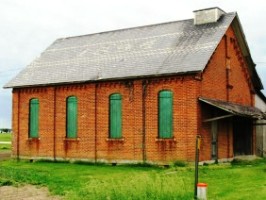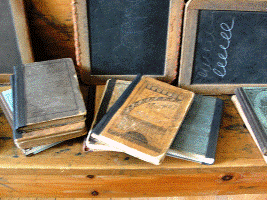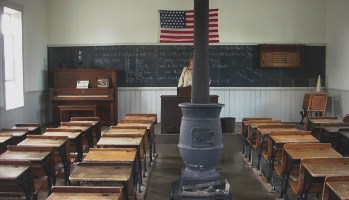Brother Oliver Weaver suggested that there was an
interesting story about how the New England School
received its name. The community was of solid
German extraction. One would have thought a name
representative of their heritage might have been
proposed. Mrs. Utendorf had donated the land with
certain stipulations but apparently not that the school
carry the Utendorf name. It seems there were two
names proposed ... New England and Frog Town
with proponents on both sides.
The following account was provided by Bernard Fenbert:
Bernard Fenbert's great grandfather, Bernard, Herman
Fenbert, favored New England. Captain Kleman (as he
was known) wanted the school called Frog Town. Both
men were German born Americans and proud of their
new country. Both men had had military careers. Both
owned sabers. They proposed to settle the matter by
fighting a duel. Now this was a serious matter but not
worth losing one?s life's blood over. There was a saw mill
across from where the duel was to take place. The
carpenter turned out wooden balls to fit on the end of the
sabers. The first to strike the other on the shoulder was
to win. Bernard Herman Fenbert can be credited with a
win. The choice was made. New England became the
name of the school. Frog Town was the name given to
what was sometimes is called the Averesch school. The
Bernard Fenbert, who gave me the story, attended New
England school. His teacher was Miss Mary Winkleman.
He had a perfect attendance record and was justly
proud of that. Of course, he told me he had perfect
grades too.
The following are Mary "Molly" (Hornung) Roof's memories
of New England school:
The New England School was located on the Base Line,
now Road M, east of Route 65. This was two miles south
of Ottawa. The school was a frame building when I
started there in 1893. The desks were double; but there
were so many children that we had to sit three in a seat.
It was heated with a long stove which burned cord wood.
The boys carried the three foot pieces of wood in each
afternoon before they went home. Many tramps soon
learned about this warm building. The teacher's desk
was located on a raised platform. It was a table-like desk.
We stood in front of his desk on the raised platform for
our classes. We were well supplied with books. Each
family furnished the books. We had reading, arithmetic,
grammar, spelling, and geography. Each child had a
wood pencil box for one pencil and one pen. The ink
was in the ink well. The paper was the yellow goldenrod
tablet, but we used our slates more than we did paper.
We had single and double slates. There was no water
at school. Twice a day the girls carried it from the
nearest neighbor in a large red bucket. Everyone drank
from the same dipper. We had another building which
consisted of the woodshed and the outhouse. The
woodshed also served as a barn for the teacher's
transportation, which might be his bicycle or her horse.
The outhouse was divided by a partition which did not
reach to the ceiling. Much looking was done on both
sides. The seat was made of two strips of wood. At first
there was no paper, but later catalogues were used.
Inside the school, on either side of the door, were
shelves and a row of nails. The shelves were for the tin
lunch pails and the nails were for the coats. The boys
used one side and the girls the other. Many lunches
were frozen when the children arrived at school, but
they thawed by noon.
My first teacher was Theodore Kerner who lived in
Ottawa. He rode a bicycle to school. Next was
Sylvester Kohls from Ft. Jennings who roomed with
a neighbor. Mary Straman used a horse and buggy.
Louis Welty lived in a log cabin.
Two forms of punishment were switching and
kneeling on a three sided piece of wood. Often the
child fainted. It was the switching that caused the
end of my schooling. The teacher drew a horse. It
was so crooked that I laughed. I had my hands
switched. That was my last day in school. My mother
wanted me to quit so she could get started on her
spring work. I was the oldest girl. I had four brothers
and six sisters. I didn't want to quit, but after my
hand switching I was glad to do so.
I think one of my teachers was the first litterbug.
Every noon he took a walk. He always walked in the
same direction, stopped at the same spot, turned
and came back to school. Many empty bottles were
found at his stopping place.
The original school was torn down and was
replaced by a brick building. This brick building
was used until about 1940. The, children then went
to Ottawa, Glandorf, and Columbus Grove.
NOTE: The brick construction probably took place
between 1907 and 1910 Confirmation not available.
I am now 94 years old and I live in Ottawa. I am
still learning. Every day I read the paper, read my
magazines, and listen to the television. My favorite
programs are the news, Lawrence Welk, and
Johnnie Carson. I am very thankful for my little red
schoolhouse education.
 This picture looks similiar to the New
England School, but not an actual photograph.
Click to view larger
This picture looks similiar to the New
England School, but not an actual photograph.
Click to view larger
 Similiar to ones used at New England School.
Click to view larger
Similiar to ones used at New England School.
Click to view larger
 No One-Room school of the time period was this
bright. But you get the idea.
Click to view larger
No One-Room school of the time period was this
bright. But you get the idea.
Click to view larger
NOTE: Mary Roof died August 3, 1981, at the age of 94. |


 This picture looks similiar to the New
England School, but not an actual photograph.
Click to view larger
This picture looks similiar to the New
England School, but not an actual photograph.
Click to view larger Similiar to ones used at New England School.
Click to view larger
Similiar to ones used at New England School.
Click to view larger No One-Room school of the time period was this
bright. But you get the idea.
Click to view larger
No One-Room school of the time period was this
bright. But you get the idea.
Click to view larger